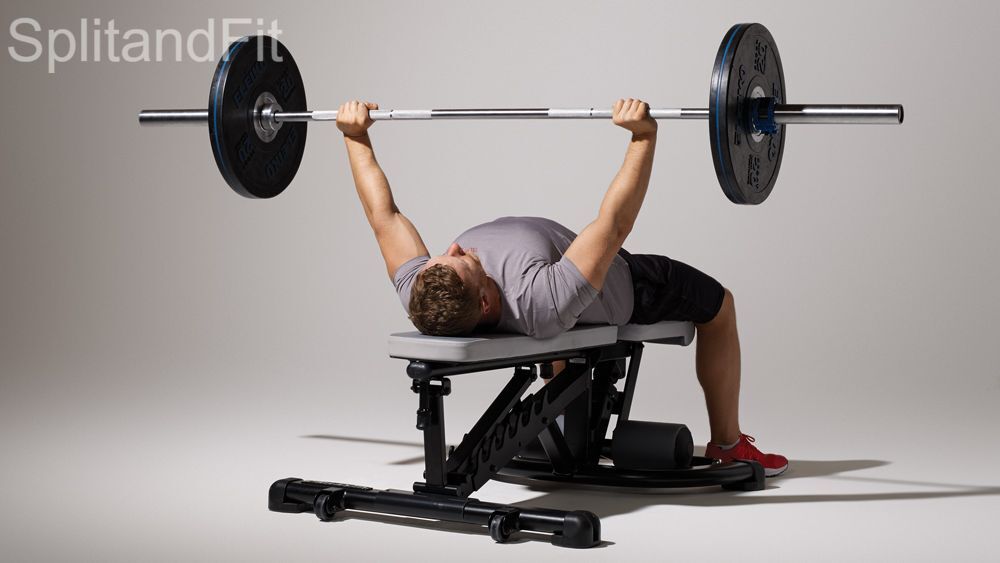If you’ve hit a plateau with your bench press, you’re not alone. Many lifters experience frustration when their bench press numbers stall. However, understanding the potential reasons behind this issue can help you break through and continue making progress. Let’s explore some common factors that could be hindering your bench press gains.
Why your Bench Press Not Progressing
Several factors could be contributing to your lack of progress with the bench press. It’s important to consider elements such as poor technique, inadequate variation in training, imbalanced muscle development, insufficient recovery, and nutritional deficiencies. Addressing these aspects comprehensively can help break through the plateau and continue making gains.

Also Read: Bench press with EZ curl bar: A Step-by-Step Video Guide
Reasons Why Bench Press Not Working
Experiencing a roadblock in your fitness journey? Let’s explore the reasons why the bench press may not be working as expected. Discover common pitfalls and effective solutions to reignite your progress and achieve the gains you deserve.
Here are the reasons why your bench press may not be yielding the expected results:
- Poor Technique: Inadequate or poor technique is a common issue that can hinder progress in the bench press. This may include improper body positioning, incorrect grip width, or an inconsistent bar path. Addressing and refining your technique could lead to significant improvements.
- Imbalanced Muscle Activation: Some individuals may struggle with activating the intended muscle groups, particularly the chest, during the bench press. Factors such as tight pecs or weak upper back muscles can contribute to this issue. Stretching exercises and focused strength training for the upper back can help address these imbalances.
- Ineffective Exercise Programming: Misunderstanding exercise programming can lead to suboptimal progress. It’s important to understand that lifting heavy weights doesn’t always equate to better results. Sometimes, focusing on quality over quantity and incorporating sufficient rest periods can be more beneficial.
- Lack of Variation: Over-reliance on a standard bench press routine without incorporating variations or addressing weak points can contribute to stalled progress. Introducing incline or decline presses, dumbbell presses, or accessory exercises can target different muscle groups and stimulate new growth.
- Nutritional and Recovery Considerations: Inadequate nutrition, insufficient protein intake, or lack of overall calorie consumption can limit muscle growth and strength development. Furthermore, inadequate recovery between workouts can impede strength gains. Proper nutrition and adequate rest are crucial for progress.
- Muscle Imbalance and Weakness: Neglecting complementary muscles, such as the back and triceps, can result in an imbalance that affects bench press strength. A well-rounded training program that addresses all muscle groups can help improve overall performance.
- Ineffective Grip and Foot Position: Utilizing an incorrect grip or foot position, or experiencing “loose back syndrome,” can negatively impact bench press performance. Ensuring proper grip, foot placement, and maintaining a stable back can significantly improve execution and results.
By addressing these factors comprehensively, individuals may be able to break through plateaus and continue making progress with their bench press routines.
How To Do Bench Press: Step-By-Step Guide
A. Set Up and Equipment Needed
- Set up a flat bench press with an appropriate weight set for your workout.
- Ensure the bar is racked at a height where you can unrack it comfortably without straining.
B. Initial Position
- Lie down on the bench with your back flat, feet firmly planted on the ground, and your eyes directly underneath the bar.
- Grip the bar slightly wider than shoulder-width apart, keeping your wrists straight and in line with your forearms.
C. Execution of the Exercise
- Unrack the bar and hold it directly above your chest with arms fully extended.
- Lower the bar towards your mid-chest in a controlled manner while keeping your elbows at a 45-degree angle from your body.
- Once the bar lightly touches your chest, press it back up to the starting position by extending your arms.
D. Breathing Tips
- Inhale deeply as you lower the bar towards your chest.
- Exhale forcefully as you push the bar back up to the starting position.
By following these step-by-step instructions and practicing proper form, you can maximize the effectiveness of your bench press routine while minimizing the risk of injury.
Common Mistakes While Doing Bench Press
Maximizing your bench press performance requires precision. Unfortunately, several common mistakes can hinder your progress. Here are the common bench press mistakes that could be hindering your progress:
- Elbows Too High: Bench pressing with elbows straight out to the sides can excessively stress the shoulder capsules and elbows, potentially leading to poor form and reduced effectiveness.
- Flaring Elbows Out at 90° Angles: Flaring the elbows out too much during the bench press can lead to inefficient muscle engagement and unnecessary stress on the shoulders.
- Improper Grip and Wrist Position: Bending the wrists backward, rolling them back, or using an improper grip width may lead to compromised form and reduced strength output during the bench press.
- Inadequate Foot Placement: Not properly planting the feet on the floor during the bench press can result in instability and reduced power transfer, impacting your overall performance.
- Incomplete Range of Motion: Failing to touch the bar to your chest or not completing the full range of motion can limit muscle activation and hinder progress in the bench press.
- Excessive Weight and Insufficient Rest: Lifting too heavy, not resting enough, or overtraining can lead to fatigue, poor recovery, and ultimately stagnation in bench press performance.
- Improper Scapula Positioning: Protracting the scapula (shoulder blades) during the bench press can compromise stability and reduce the effectiveness of the exercise.
By addressing these mistakes through proper form, technique correction, and a balanced approach to training, you can potentially enhance your bench press performance and overall progress.
Muscles Worked in Bench Press
Here are the muscles worked during a bench press, based on the information gathered from various sources:
- Pectoralis Major: The primary muscle engaged during a bench press, responsible for the horizontal adduction of the shoulder joint and the flexion of the humerus. It is the main muscle responsible for the pressing motion and contributes significantly to chest development.
- Pectoralis Minor: This muscle, located underneath the pectoralis major, assists in stabilizing the shoulder blades during the bench press movement and plays a supportive role in the pressing action.
- Anterior Deltoids: The front portion of the shoulder muscles is actively involved in the initial phase of the bench press, aiding in shoulder flexion and contributing to the pressing movement.
- Triceps Brachii: As a secondary muscle group, the triceps are engaged during the lockout phase of the bench press, playing a pivotal role in elbow extension and providing stability and strength throughout the movement.
Understanding the specific muscles worked during the bench press can help individuals optimize their training programs and ensure balanced muscle development across the upper body.
How to Overcome Bench Press Plateaus: Tips for Improvement
Facing a standstill in your bench press progress can be discouraging, but fear not! By implementing a few key tips, you can break through plateaus and get back on the road to improvement:
- Refine Your Technique: Pay close attention to form and execution. Focus on pulling your shoulder blades back, tucking in your elbows at the bottom of the movement, and bringing the bar down to the spot where your chest ends and your core starts. Maintaining proper form throughout the exercise is crucial for optimizing muscle engagement and progression.
- Increase Training Frequency: Consider training the bench press more often to stimulate muscle adaptation and growth. Increasing the frequency of upper body movements like the bench press can potentially lead to improved strength gains and performance.
- Chest Engagement: Emphasize chest engagement by actively puffing your chest up to the bar as the bar descends and maintaining this position throughout the movement. This can help maximize the involvement of the pectoralis major and minor muscles, contributing to enhanced bench press performance.
- Focus on Proper Programming: Ensure that your exercise programming aligns with your specific goals and abilities. Understanding exercise programming and tailoring it to your needs can play a significant role in breaking through plateaus and achieving progress in the bench press.
- Address Shoulder Issues: If you’re experiencing shoulder problems, prioritize addressing these issues before focusing on improving your bench press. Engage in shoulder-specific exercises and rehabilitation to enhance shoulder stability and function, which can positively impact your bench press performance.
- Mind-Muscle Connection: Develop a strong mind-muscle connection to ensure that you are adequately engaging the targeted muscles during the bench press. This can help overcome common mistakes and improve overall muscle recruitment for better progress.
By implementing these strategies and paying close attention to the key factors hindering your bench press progression, you can work towards breaking through plateaus and achieving improved performance in your training routine.

Frequent Question Answers
| Question | Answer |
|---|---|
| Why do I not progress on bench press? | Poor technique, lack of variation, inadequate rest and recovery, improper programming, insufficient muscle engagement |
| How do I increase my bench press progressively? | Refine technique, increase training frequency, emphasize chest engagement, focus on proper programming, mind-muscle connection |
| Why is my bench press increasing slowly? | Improper technique, lack of chest engagement, inadequate programming, insufficient recovery, shoulder issues |
| Why am I struggling with bench press? | Lack of proper form, insufficient muscle engagement, inadequate recovery, lack of variation, poor exercise programming |
| Why my chest isn’t growing? | Inadequate chest engagement, lack of variation in training, poor mind-muscle connection, improper exercise programming |
| Why is chest so hard to build? | Lack of proper chest engagement, inadequate training variation, poor programming, inadequate mind-muscle connection, improper technique |
| Is 40 kg A Good bench press? | The assessment of a “good” bench press weight can vary based on individual factors such as body weight, training experience, and fitness goals. |
| Is 60 kg A Good bench press? | The assessment of a “good” bench press weight can vary based on individual factors such as body weight, training experience, and fitness goals. |
| Why is my chest so weak? | Insufficient chest engagement, lack of proper training, inadequate muscle development, poor mind-muscle connection, improper exercise programming |
Conclusion
The key to strengthening your arm for softball lies in targeted exercises such as External Rotations, Subscapularis Strengthening, Wrist Curls, Sword Pulls, and Resistance Band Exercises. Consistent practice of these exercises, combined with a focus on proper throwing mechanics, can significantly improve arm strength and overall performance in softball.






Leave a Reply